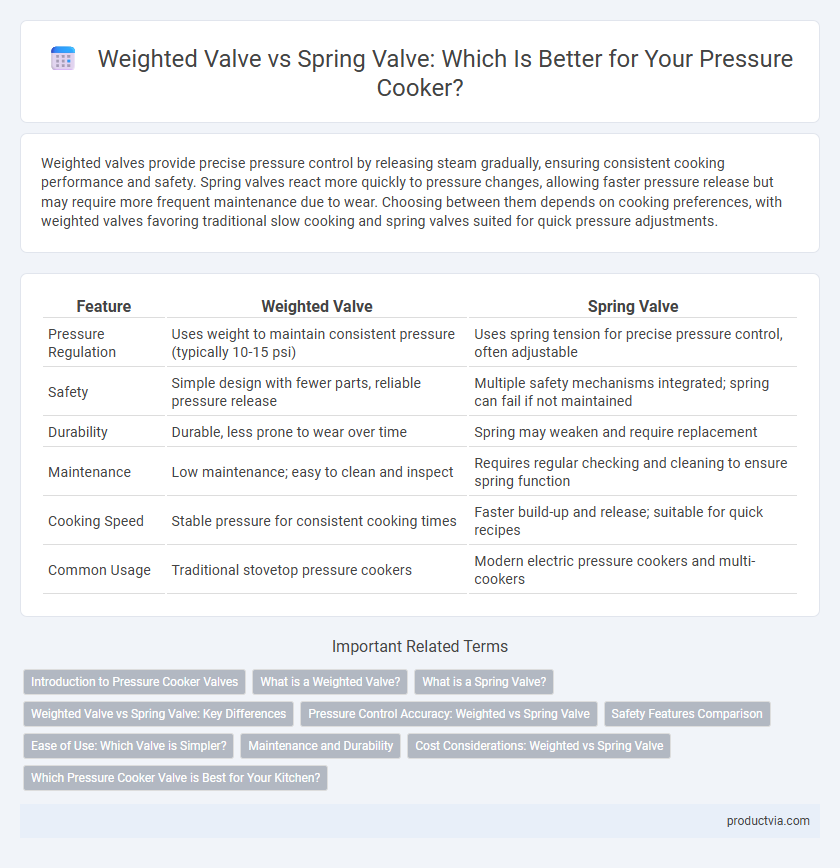Weighted valves provide precise pressure control by releasing steam gradually, ensuring consistent cooking performance and safety. Spring valves react more quickly to pressure changes, allowing faster pressure release but may require more frequent maintenance due to wear. Choosing between them depends on cooking preferences, with weighted valves favoring traditional slow cooking and spring valves suited for quick pressure adjustments.
Table of Comparison
| Feature | Weighted Valve | Spring Valve |
|---|---|---|
| Pressure Regulation | Uses weight to maintain consistent pressure (typically 10-15 psi) | Uses spring tension for precise pressure control, often adjustable |
| Safety | Simple design with fewer parts, reliable pressure release | Multiple safety mechanisms integrated; spring can fail if not maintained |
| Durability | Durable, less prone to wear over time | Spring may weaken and require replacement |
| Maintenance | Low maintenance; easy to clean and inspect | Requires regular checking and cleaning to ensure spring function |
| Cooking Speed | Stable pressure for consistent cooking times | Faster build-up and release; suitable for quick recipes |
| Common Usage | Traditional stovetop pressure cookers | Modern electric pressure cookers and multi-cookers |
Introduction to Pressure Cooker Valves
Pressure cooker valves regulate internal pressure by controlling steam release, ensuring safe and efficient cooking. Weighted valves function by using a hinge and a weight that lifts to release excess steam at specific pressure levels, offering consistent pressure control. Spring valves rely on a spring mechanism that compresses under increasing pressure to release steam, providing precise pressure management for modern cookers.
What is a Weighted Valve?
A weighted valve, also known as a jiggler, regulates pressure in a pressure cooker by using a set weight to release steam at a specific pressure threshold, ensuring consistent cooking performance. This valve operates by lifting and dropping intermittently, allowing excess steam to escape and maintaining a steady internal pressure. Weighted valves are favored for their simplicity, durability, and effective pressure control compared to spring valves.
What is a Spring Valve?
A spring valve in a pressure cooker functions as a safety mechanism that regulates internal pressure by allowing steam to escape once a preset pressure threshold is reached. Unlike weighted valves that rely on gravity, spring valves use a calibrated spring to maintain consistent pressure levels, ensuring precise control during cooking. This type of valve enhances safety by automatically releasing excess steam, preventing pressure buildup and potential hazards.
Weighted Valve vs Spring Valve: Key Differences
Weighted valves rely on gravity to maintain pressure by using a weighted cap that rocks or jiggles to release steam, providing consistent pressure control ideal for traditional stovetop pressure cookers. Spring valves use a spring-loaded mechanism that activates at a preset pressure to release excess steam, offering more precise pressure regulation and faster response times common in modern electric pressure cookers. The key differences lie in the mechanisms: weighted valves provide simpler, manual pressure control with visual steam release, while spring valves deliver automated, accurate pressure management with added safety features.
Pressure Control Accuracy: Weighted vs Spring Valve
Weighted valves provide more precise pressure control in pressure cookers by regulating steam release through mass-based calibration, ensuring consistent pressure levels. Spring valves rely on spring tension to maintain pressure, which can lead to variability due to wear or temperature changes, reducing accuracy. For applications requiring strict pressure stability, weighted valves are generally more reliable than spring valves.
Safety Features Comparison
Weighted valves in pressure cookers provide precise pressure regulation by releasing steam at specific pressure levels, enhancing safety through controlled venting. Spring valves offer quicker pressure release due to their mechanical design but require accurate calibration to prevent premature or delayed venting, impacting overall safety. Both valve types incorporate fail-safe mechanisms, yet weighted valves are often preferred for their consistent pressure maintenance and reduced risk of sudden pressure surges.
Ease of Use: Which Valve is Simpler?
Weighted valves offer simpler ease of use due to their straightforward design, which automatically regulates pressure without manual adjustment. Spring valves require more user attention to monitor and control pressure settings, making them less intuitive for beginners. The weighted valve's automatic pressure release system enhances safety and convenience, especially for those new to pressure cooking.
Maintenance and Durability
Weighted valves in pressure cookers require minimal maintenance due to their simple design and fewer moving parts, enhancing their durability and reliability over time. Spring valves demand regular inspection and cleaning to prevent wear and tear on the spring mechanism, which can compromise safety and longevity. Choosing a weighted valve often results in lower maintenance efforts and extended durability, making it preferable for consistent, long-term use.
Cost Considerations: Weighted vs Spring Valve
Weighted valves for pressure cookers generally come at a higher initial cost due to their durable cast iron or stainless steel construction, offering long-term reliability. Spring valves, made from simpler materials like aluminum and rubber gaskets, are more budget-friendly but may require frequent replacement, increasing maintenance expenses. Cost considerations should balance upfront investment in weighted valves against potential ongoing costs associated with spring valve wear and replacement.
Which Pressure Cooker Valve is Best for Your Kitchen?
Weighted valves provide precise pressure control and durability, making them ideal for traditional stovetop pressure cookers, as they regulate steam release by their weight. Spring valves offer faster pressure buildup and enhanced safety features, often found in electric pressure cookers, using a spring mechanism to maintain consistent pressure levels. Choosing between weighted or spring valves depends on cooking style, convenience preferences, and compatibility with your kitchen appliances.
Weighted valve vs Spring valve for pressure cooker Infographic

 productvia.com
productvia.com